Lancia Voyager 2012 Owner handbook (in English)
Manufacturer: LANCIA, Model Year: 2012, Model line: Voyager, Model: Lancia Voyager 2012Pages: 344, PDF Size: 3.95 MB
Page 251 of 344
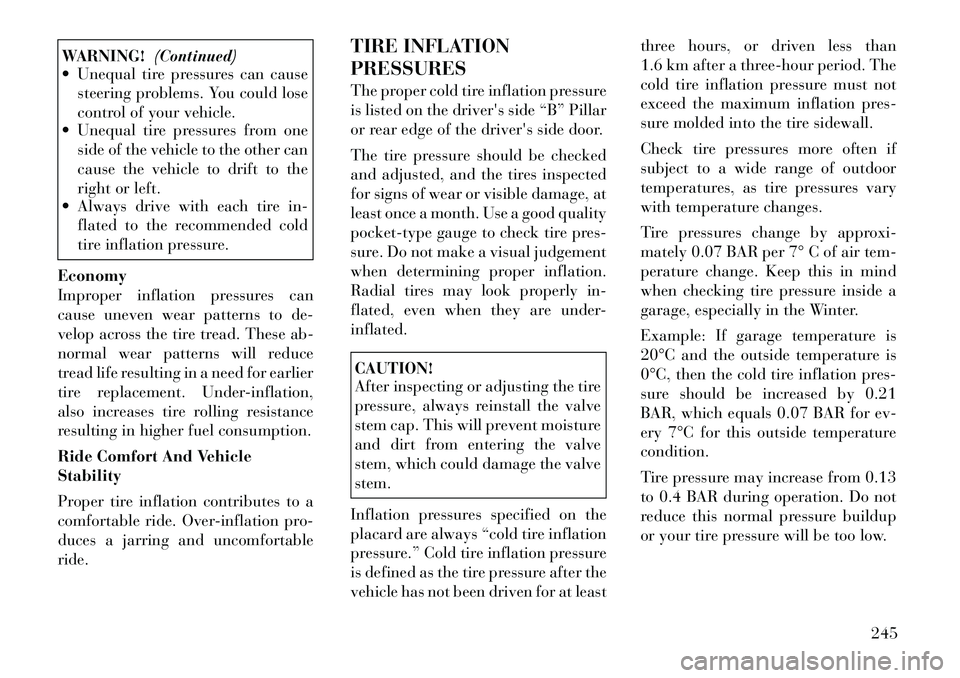
WARNING!(Continued)
Unequal tire pressures can cause
steering problems. You could lose
control of your vehicle.
Unequal tire pressures from one
side of the vehicle to the other can
cause the vehicle to drift to the
right or left.
Always drive with each tire in-
flated to the recommended cold
tire inflation pressure.
Economy
Improper inflation pressures can
cause uneven wear patterns to de-
velop across the tire tread. These ab-
normal wear patterns will reduce
tread life resulting in a need for earlier
tire replacement. Under-inflation,
also increases tire rolling resistance
resulting in higher fuel consumption.
Ride Comfort And Vehicle
Stability
Proper tire inflation contributes to a
comfortable ride. Over-inflation pro-
duces a jarring and uncomfortable
ride. TIRE INFLATION
PRESSURES
The proper cold tire inflation pressure
is listed on the
driver's side “B” Pillar
or rear edge of the driver's side door.
The tire pressure should be checked
and adjusted, and the tires inspected
for signs of wear or visible damage, at
least once a month. Use a good quality
pocket-type gauge to check tire pres-
sure. Do not make a visual judgement
when determining proper inflation.
Radial tires may look properly in-
flated, even when they are under-
inflated.
CAUTION!
After inspecting or adjusting the tire
pressure, always reinstall the valve
stem cap. This will prevent moisture
and dirt from entering the valve
stem, which could damage the valve
stem.
Inflation pressures specified on the
placard are always “cold tire inflation
pressure.” Cold tire inflation pressure
is defined as the tire pressure after the
vehicle has not been driven for at least three hours, or driven less than
1.6 km after a three-hour period. The
cold tire inflation pressure must not
exceed the maximum inflation pres-
sure molded into the tire sidewall.
Check tire pressures more often if
subject to a wide range of outdoor
temperatures, as tire pressures vary
with temperature changes.
Tire pressures change by approxi-
mately 0.07 BAR per 7° C of air tem-
perature change. Keep this in mind
when checking tire pressure inside a
garage, especially in the Winter.
Example: If garage temperature is
20°C and the outside temperature is
0°C, then the cold tire inflation pres-
sure should be increased by 0.21
BAR, which equals 0.07 BAR for ev-
ery 7°C for this outside temperature
condition.
Tire pressure may increase from 0.13
to 0.4 BAR during operation. Do not
reduce this normal pressure buildup
or your tire pressure will be too low.
245
Page 252 of 344
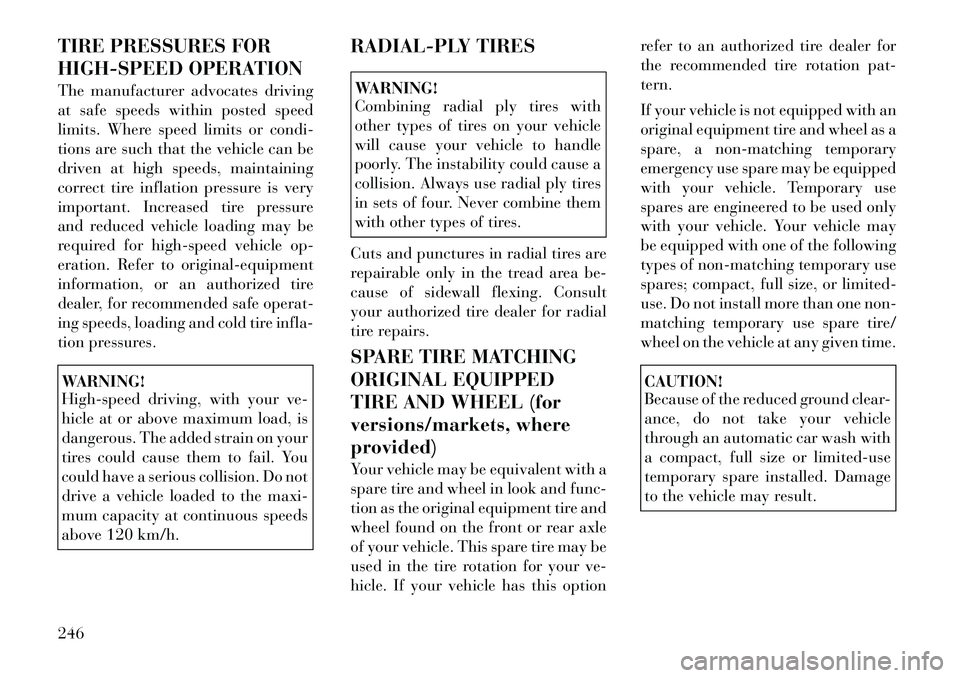
TIRE PRESSURES FOR
HIGH-SPEED OPERATION
The manufacturer advocates driving
at safe speeds within posted speed
limits. Where speed limits or condi-
tions are such that the vehicle can be
driven at high speeds, maintaining
correct tire inflation pressure is very
important. Increased tire pressure
and reduced vehicle loading may be
required for high-speed vehicle op-
eration. Refer to original-equipment
information, or an authorized tire
dealer, for recommended safe operat-
ing speeds, loading and cold tire infla-
tion pressures.WARNING!
High-speed driving, with your ve-
hicle at or above maximum load, is
dangerous. The added strain on your
tires could cause them to fail. You
could have a serious collision. Do not
drive a vehicle loaded to the maxi-
mum capacity at continuous speeds
above 120 km/h.RADIAL-PLY TIRES
WARNING!
Combining radial ply tires with
other types of tires on your vehicle
will cause your vehicle to handle
poorly. The instability could cause a
collision. Always use radial ply tires
in sets of four. Never combine them
with other types of tires.
Cuts and punctures in radial tires are
repairable only in the tread area be-
cause of sidewall flexing. Consult
your authorized tire dealer for radial
tire repairs.
SPARE TIRE MATCHING
ORIGINAL EQUIPPED
TIRE AND WHEEL (for
versions/markets, where
provided)
Your vehicle may be equivalent with a
spare tire and wheel in look and func-
tion as the original equipment tire and
wheel found on the front or rear axle
of your vehicle. This spare tire may be
used in the tire rotation for your ve-
hicle. If your vehicle has this option refer to an authorized tire dealer for
the recommended tire rotation pat-
tern.
If your vehicle is not equipped with an
original equipment tire and wheel as a
spare, a non-matching temporary
emergency use spare may be equipped
with your vehicle. Temporary use
spares are engineered to be used only
with your vehicle. Your vehicle may
be equipped with one of the following
types of non-matching temporary use
spares; compact, full size, or limited-
use. Do not install more than one non-
matching temporary use spare tire/
wheel on the vehicle at any given time.
CAUTION!
Because of the reduced ground clear-
ance, do not take your vehicle
through an automatic car wash with
a compact, full size or limited-use
temporary spare installed. Damage
to the vehicle may result.
246
Page 253 of 344
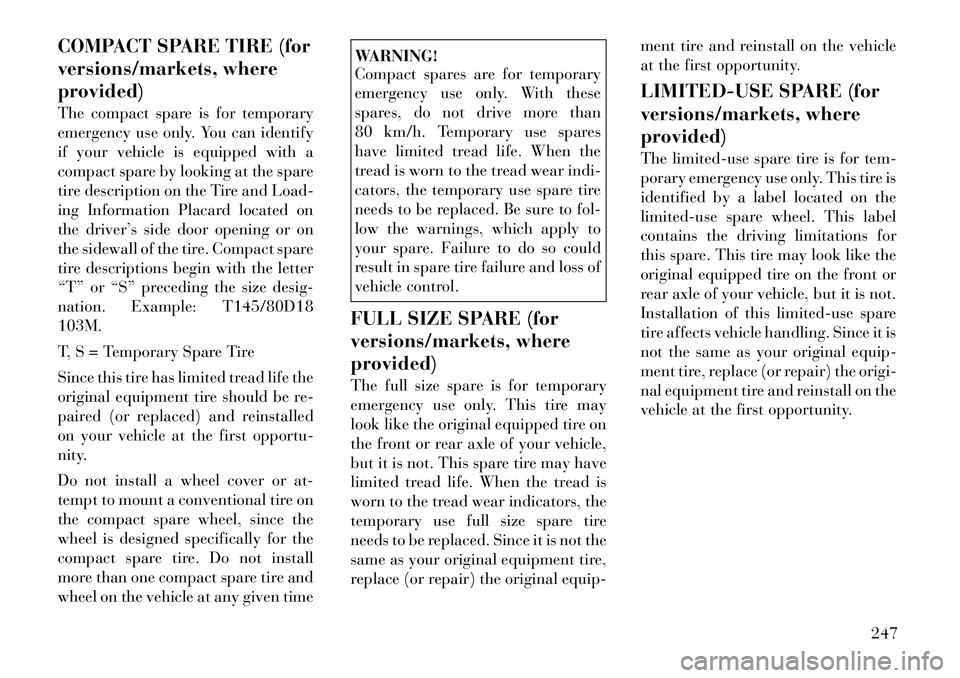
COMPACT SPARE TIRE (for
versions/markets, where
provided)
The compact spare is for temporary
emergency use only. You can identify
if your vehicle is equipped with a
compact spare by looking at the spare
tire description on the Tire and Load-
ing Information Placard located on
the driver’s side door opening or on
the sidewall of the tire. Compact spare
tire descriptions begin with the letter
“T” or “S” preceding the size desig-
nation. Example: T145/80D18
103M.
T, S = Temporary Spare Tire
Since this tire has limited tread life the
original equipment tire should be re-
paired (or replaced) and reinstalled
on your vehicle at the first opportu-
nity.
Do not install a wheel cover or at-
tempt to mount a conventional tire on
the compact spare wheel, since the
wheel is designed specifically for the
compact spare tire. Do not install
more than one compact spare tire and
wheel on the vehicle at any given time
WARNING!
Compact spares are for temporary
emergency use only. With these
spares, do not drive more than
80 km/h. Temporary use spares
have limited tread life. When the
tread is worn to the tread wear indi-
cators, the temporary use spare tire
needs to be replaced. Be sure to fol-
low the warnings, which apply to
your spare. Failure to do so could
result in spare tire failure and loss of
vehicle control.
FULL SIZE SPARE (for
versions/markets, where
provided)
The full size spare is for temporary
emergency use only. This tire may
look like the original equipped tire on
the front or rear axle of your vehicle,
but it is not. This spare tire may have
limited tread life. When the tread is
worn to the tread wear indicators, the
temporary use full size spare tire
needs to be replaced. Since it is not the
same as your original equipment tire,
replace (or repair) the original equip- ment tire and reinstall on the vehicle
at the first opportunity.
LIMITED-USE SPARE (for
versions/markets, where
provided)
The limited-use spare tire is for tem-
porary emergency use only. This tire is
identified by a label located on the
limited-use spare wheel. This label
contains the driving limitations for
this spare. This tire may look like the
original equipped tire on the front or
rear axle of your vehicle, but it is not.
Installation of this limited-use spare
tire affects vehicle handling. Since it is
not the same as your original equip-
ment tire, replace (or repair) the origi-
nal equipment tire and reinstall on the
vehicle at the first opportunity.
247
Page 254 of 344

WARNING!
Limited-use spares are for emer-
gency use only. Installation of this
limited-use spare tire affects vehicle
handling. With this tire, do not drive
more than the speed listed on the
limit-use spare wheel. Keep inflated
to the cold tire inflation pressure
listed on your Tire and Loading In-
formation Placard located on the
driver’s side door opening. Replace
(or repair) the original equipment
tire at the first opportunity and rein-
stall it on your vehicle. Failure to do
so could result in loss of vehicle con-
trol.
TIRE SPINNING
When stuck in mud, sand, snow, or ice
conditions, do not spin your vehicle's
wheels faster than 48 km/h, or for
more than 30 seconds continuously,
without stopping.
Refer to “Freeing A Stuck Vehicle” in
“What To Do In Emergencies” for fur -
ther information.
WARNING!
Fast spinning tires can be danger- ous. Forces generated by excessive
wheel speeds may cause tire dam-
age or failure. A tire could explode
and injure someone.
Do not spin your vehicle's wheels
faster than 48 km/h, or for more
than 30 seconds continuously,
when you are stuck; and do not let
anyone near a spinning wheel, no
matter what the speed.
TREAD WEAR
INDICATORS
Tread wear indicators are in the
original-equipment tires to help you
in determining when your tires should
be replaced. These indicators are molded into the
bottom of the tread grooves. They will
appear as bands when the tread depth
becomes 2 mm. When the tread is
worn to the tread wear indicators, the
tire should be replaced.
LIFE OF TIRE
The service life of a tire is dependent
upon varying factors, including, but
not limited to:
Driving style
Tire pressure
Distance driven
WARNING!
The tires and the spare tire should be
replaced after six years, regardless of
the remaining tread. Failure to fol-
low this warning can result in sud-
den tire failure. You could lose con-
trol and have a collision resulting in
serious injury or death.
Keep dismounted tires in a cool, dry
place with as little exposure to light as
possible. Protect tires from contact
with oil, grease and gasoline.
1 — Worn Tire
2 — New Tire
248
Page 255 of 344

REPLACEMENT TIRES
The tires on your new vehicle provide
a balance of many characteristics.
They should be inspected regularly
for wear and correct cold tire inflation
pressure. The manufacturer strongly
recommends that you use tires
equivalent to the originals in size,
quality and performance when re-
placement is needed. Please see
“Tread Wear Indicators” and “Tire
and Loading Information” placard
for the size designation of your tire.
The Load Index and Speed Symbol
for your tire will be found on the
original equipment tire sidewall. See
the Tire Sizing Chart example found
in the Tire Safety Information section
of this manual for more information
relating to the Load Index and Speed
Symbol of a tire.
It is recommended to replace the two
front tires or two rear tires as a pair.
Replacing just one tire can seriously
affect your vehicle’s handling. If you
ever replace a wheel, make sure that
the wheel’s specifications match those
of the original wheels.It is recommended you contact your
original equipment or an authorized
tire dealer with any questions you
may have on tire specifications or ca-
pability. Failure to use equivalent re-
placement tires may adversely affect
the safety, handling, and ride of your
vehicle.
WARNING!
Do not use a tire, wheel size or
rating other than that specified
for your vehicle. Some combina-
tions of unapproved tires and
wheels may change suspension di-
mensions and performance char-
acteristics, resulting in changes to
steering, handling, and braking of
your vehicle. This can cause un-
predictable handling and stress to
steering and suspension compo-
nents. You could lose control and
have a collision resulting in seri-
ous injury or death. Use only the
tire and wheel sizes with load rat-
ings approved for your vehicle.
(Continued)
WARNING!(Continued)
Never use a tire with a smaller
load index or capacity, than what
was originally equipped on your
vehicle. Using a tire with a smaller
load index could result in tire
overloading and failure. You
could lose control and have a col-
lision.
Failure to equip your vehicle with
tires having adequate speed capa-
bility can result in sudden tire fail-
ure and loss of vehicle control.CAUTION!
Replacing original tires with tires of
a different size may result in false
speedometer and odometer read-
ings.
TIRE CHAINS
Use of Security Chain Company
(SCC) Super Z6 SZ-143 or Iceman
Z6 IZ-643 cables or equivalent are
recommended on 225/65R17 tires.
NOTE:
Do not use tire chains on a com-
pact spare tire.
249
Page 256 of 344
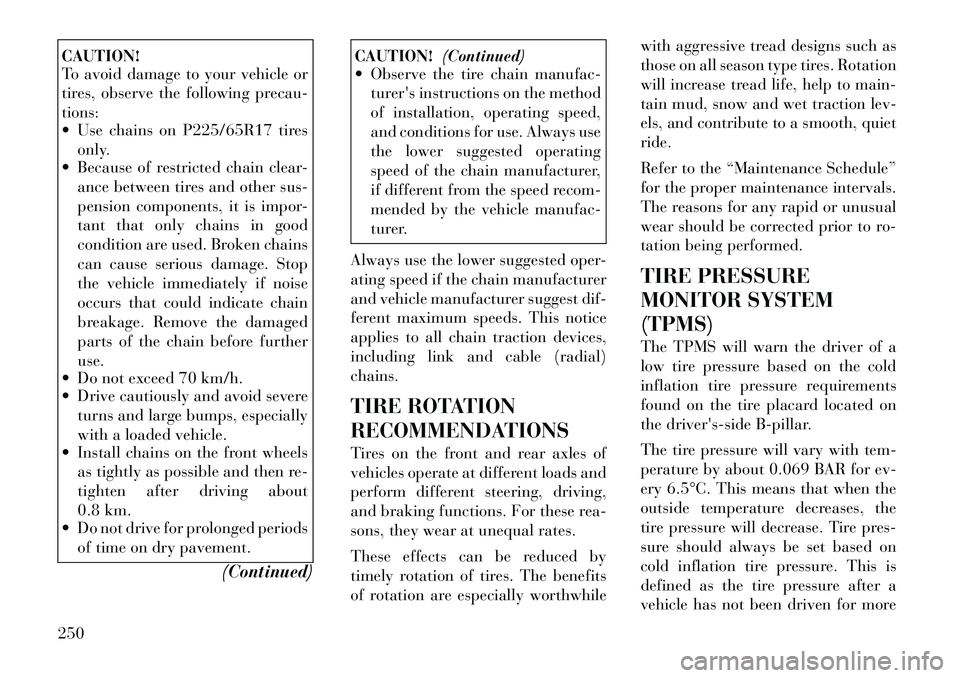
CAUTION!
To avoid damage to your vehicle or
tires, observe the following precau-
tions:
Use chains on P225/65R17 tiresonly.
Because of restricted chain clear-
ance between tires and other sus-
pension components, it is impor-
tant that only chains in good
condition are used. Broken chains
can cause serious damage. Stop
the vehicle immediately if noise
occurs that could indicate chain
breakage. Remove the damaged
parts of the chain before further
use.
Do not exceed 70 km/h.
Drive cautiously and avoid severe
turns and large bumps, especially
with a loaded vehicle.
Install chains on the front wheels
as tightly as possible and then re-
tighten after driving about
0.8 km.
Do not drive for prolonged periods
of time on dry pavement.
(Continued)
CAUTION!(Continued)
Observe the tire chain manufac-
tur er's instructions on the method
of installation, operating speed,
and conditions for use. Always use
the lower suggested operating
speed of the chain manufacturer,
if different from the speed r ecom-
mended by the vehicle manufac-
turer.
Always use the lower suggested oper-
ating speed if the chain manufacturer
and vehicle manufacturer suggest dif-
ferent maximum speeds. This notice
applies to all chain traction devices,
including link and cable (radial)
chains.
TIRE ROTATION
RECOMMENDATIONS
Tires on the front and rear axles of
vehicles operate at different loads and
perform different steering, driving,
and braking functions. For these rea-
sons, they wear at unequal rates.
These effects can be reduced by
timely rotation of tires. The benefits
of rotation are especially worthwhile with aggressive tread designs such as
those on all season type tires. Rotation
will increase tread life, help to main-
tain mud, snow and wet traction lev-
els, and contribute to a smooth, quiet
ride.
Refer to the “Maintenance Schedule”
for the proper maintenance intervals.
The reasons for any rapid or unusual
wear should be corrected prior to ro-
tation being performed.
TIRE PRESSURE
MONITOR SYSTEM
(TPMS)
The TPMS will warn the driver of a
low tire pressure based on the cold
inflation tire pressure requirements
found on the tire placard located on
the
driver's-side B-pillar.
The tire pressure will vary with tem-
perature by about 0.069 BAR for ev-
ery 6.5°C. This means that when the
outside temperature decreases, the
tire pressure will decrease. Tire pres-
sure should always be set based on
cold inflation tire pressure. This is
defined as the tire pressure after a
vehicle has not been driven for more
250
Page 257 of 344
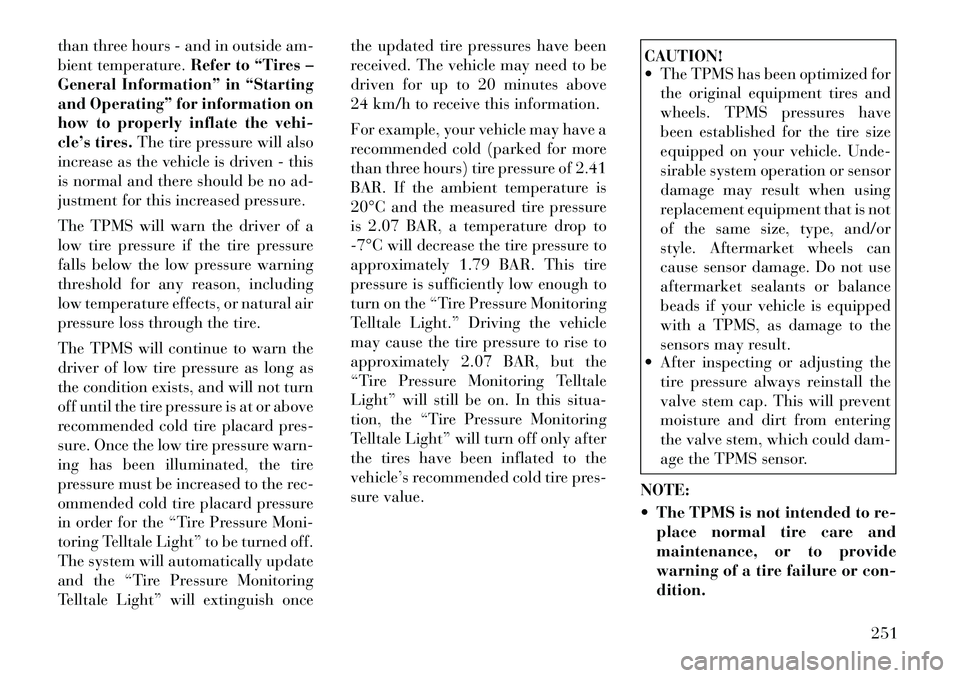
than three hours - and in outside am-
bient temperature.Refer to “Tires –
General Information” in “Starting
and Operating” for information on
how to properly inflate the vehi-
cle’s tires. The tire pressure will also
increase as the vehicle is driven - this
is normal and there should be no ad-
justment for this increased pressure.
The TPMS will warn the driver of a
low tire pressure if the tire pressure
falls below the low pressure warning
threshold for any reason, including
low temperature effects, or natural air
pressure loss through the tire.
The TPMS will continue to warn the
driver of low tire pressure as long as
the condition exists, and will not turn
off until the tire pressure is at or above
recommended cold tire placard pres-
sure. Once the low tire pressure warn-
ing has been illuminated, the tire
pressure must be increased to the rec-
ommended cold tire placard pressure
in order for the “Tire Pressure Moni-
toring Telltale Light” to be turned off.
The system will automatically update
and the “Tire Pressure Monitoring
Telltale Light” will extinguish once the updated tire pressures have been
received. The vehicle may need to be
driven for up to 20 minutes above
24 km/h to receive this information.
For example, your vehicle may have a
recommended cold (parked for more
than three hours) tire pressure of 2.41
BAR. If the ambient temperature is
20°C and the measured tire pressure
is 2.07 BAR, a temperature drop to
7°C will decrease the tire pressure to
approximately 1.79 BAR. This tire
pressure is sufficiently low enough to
turn on the “Tire Pressure Monitoring
Telltale Light.” Driving the vehicle
may cause the tire pressure to rise to
approximately 2.07 BAR, but the
“Tire Pressure Monitoring Telltale
Light” will still be on. In this situa-
tion, the “Tire Pressure Monitoring
Telltale Light” will turn off only after
the tires have been inflated to the
vehicle’s recommended cold tire pres-
sure value.
CAUTION!
The TPMS has been optimized for
the original equipment tires and
wheels. TPMS pressures have
been established for the tire size
equipped on your vehicle. Unde-
sirable system operation or sensor
damage may result when using
replacement equipment that is not
of the same size, type, and/or
style. Aftermarket wheels can
cause sensor damage. Do not use
aftermarket sealants or balance
beads if your vehicle is equipped
with a TPMS, as damage to the
sensors may result.
After inspecting or adjusting the
tire pressure always reinstall the
valve stem cap. This will prevent
moisture and dirt from entering
the valve stem, which could dam-
age the TPMS sensor.
NOTE:
The TPMS is not intended to re- place normal tire care and
maintenance, or to provide
warning of a tire failure or con-
dition.
251
Page 258 of 344
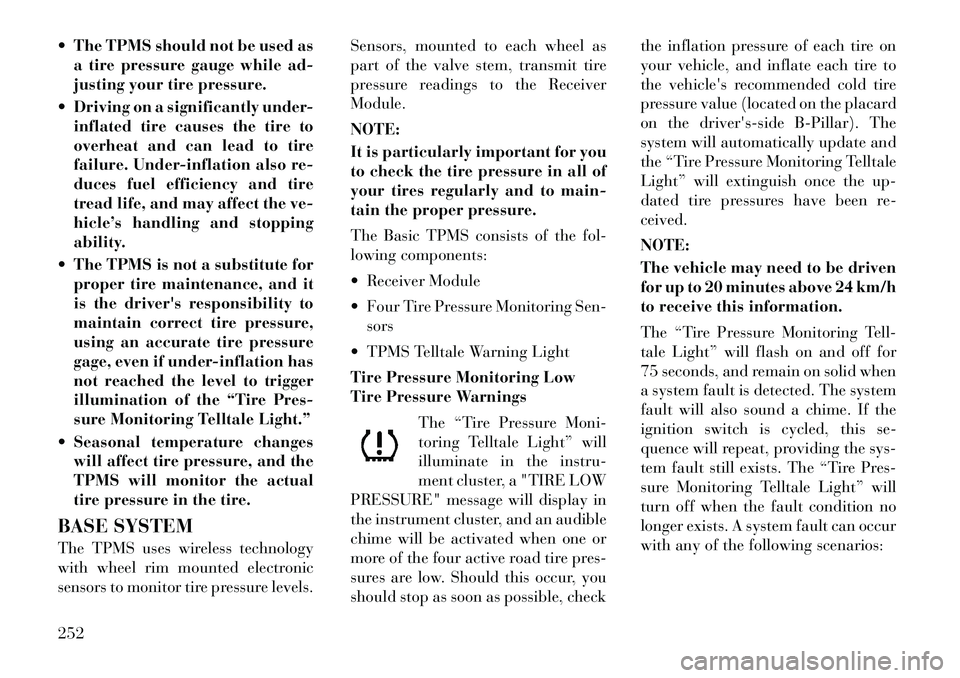
The TPMS should not be used asa tire pressure gauge while ad-
justing your tire pressure.
Driving on a significantly under- inflated tire causes the tire to
overheat and can lead to tire
failure. Under-inflation also re-
duces fuel efficiency and tire
tread life, and may affect the ve-
hicle’s handling and stopping
ability.
The TPMS is not a substitute for proper tire maintenance, and it
is the driver's responsibility to
maintain correct tire pressure,
using an accurate tire pressure
gage, even if under-inflation has
not reached the level to trigger
illumination of the “Tire Pres-
sure Monitoring Telltale Light.”
Seasonal temperature changes will affect tire pressure, and the
TPMS will monitor the actual
tire pressure in the tire.
BASE SYSTEM
The TPMS uses wireless technology
with wheel rim mounted electronic
sensors to monitor tire pressure levels. Sensors, mounted to each wheel as
part of the valve stem, transmit tire
pressure readings to the Receiver
Module.
NOTE:
It is particularly important for you
to check the tire pressure in all of
your tires regularly and to main-
tain the proper pressure.
The Basic TPMS consists of the fol-
lowing components:
Receiver Module
Four Tire Pressure Monitoring Sen-
sors
TPMS Telltale Warning Light
Tire Pressure Monitoring Low
Tire Pressure Warnings The “Tire Pressure Moni-
toring Telltale Light” will
illuminate in the instru-
ment cluster, a "TIRE LOW
PRESSURE" message will display in
the instrument cluster, and an audible
chime will be activated when one or
more of the four active road tire pres-
sures are low. Should this occur, you
should stop as soon as possible, check the inflation pressure of each tire on
your vehicle, and inflate each tire to
the vehicle's recommended cold tire
pressure value (located on the placard
on the driver's-side B-Pillar). The
system will automatically update and
the “Tire Pressure Monitoring Telltale
Light” will extinguish once the up-
dated tire pressures have been re-
ceived.
NOTE:
The vehicle may need to be driven
for up to 20 minutes above 24 km/h
to receive this information.
The “Tire Pressure Monitoring Tell-
tale Light” will flash on and off for
75 seconds, and remain on solid when
a system fault is detected. The system
fault will also sound a chime. If the
ignition switch is cycled, this se-
quence will repeat, providing the sys-
tem fault still exists. The “Tire Pres-
sure Monitoring Telltale Light” will
turn off when the fault condition no
longer exists. A system fault can occur
with any of the following scenarios:252
Page 259 of 344

1. Jamming due to electronic devices
or driving next to facilities emitting
the same radio frequencies as the
TPMS sensors.
2. Installing some form of aftermar-
ket window tinting that affects radio
wave signals.
3. Accumulation of excessive snow
and/or ice around the wheels or wheel
housings.
4. Using tire chains on the vehicle.
5. Using wheels/tires not equipped
with TPMS sensors.
Vehicles With Compact Spare
1. The compact spare tire (for
versions/markets, where provided)
does not have a TPMS sensor. There-
fore the TPMS will not monitor the
pressure in the compact spare tire.
2. If you install the compact spare
tire in place of a road tire that has a
pressure below the low-pressure
warning limit, upon the next ignition
switch cycle, a chime will sound, a
"TIRE LOW PRESSURE" messagewill be displayed and the “Tire Pres-
sure Monitoring Telltale Light” will
turn on.
3. After driving for up to 20 minutes
above 24 km/h, the “Tire Pressure
Monitoring Telltale Light” will flash
on and off for 75 seconds and then
remain on solid.
4. For each subsequent ignition
switch cycle, a chime will sound, the
“Tire Pressure Monitoring Telltale
Light” will flash on and off for 75 sec-
onds and then remain on solid.
5. Once you repair or replace the
original road tire and reinstall it on
the vehicle in place of the compact
spare tire, the TPMS will automati-
cally update, and the “Tire Pressure
Monitoring Telltale Light” will turn
off as long as no tire pressure is below
the low-pressure warning limit in any
of the four active road tires. The ve-
hicle may need to be driven for up to
20 minutes above 24 km/h for the
TPMS to receive this information.
TPMS Deactivation And
Reactivation
The TPMS can be deactivated if re-
placing all four wheel and tire assem-
blies (road tires) with wheel and tire
assemblies that do not have TPMS
Sensors, such as when installing win-
ter wheel and tire assemblies on your
vehicle. To deactivate the TPMS, first,
replace all four wheel and tire assem-
blies (road tires) with those not
equipped with TPM Sensors. Then,
drive the vehicle for at least 20 min-
utes above 24 km/h. The TPMS will
chime and the “TPM Telltale Light”
will flash on and off for 75 seconds
and then remain on solid. Upon the
next ignition switch cycle, the TPMS
will no longer chime or turn on the
“Tire Pressure Monitoring Telltale
Light.” To reactivate the TPMS, first,
replace all four wheel and tire assem-
blies (road tires) with those equipped
with TPM Sensors. Then, drive the
vehicle for up to 20 minutes above
24 km/h. The TPMS will chime and
the “Tire Pressure Monitoring Telltale
Light” will flash on and off for 75 sec-
onds.
253
Page 260 of 344

PREMIUM SYSTEM (for
versions/markets, where
provided)
The TPMS uses wireless technology
with wheel rim-mounted electronic
sensors to monitor tire pressure levels.
Sensors mounted to each wheel as
part of the valve stem transmit tire
pressure readings to the Receiver
Module.
NOTE:
It is particularly important to
regularly check and maintain
proper tire pressure in all the tires.
The Premium TPMS consists of the
following components:
Receiver Module
Four TPMS Sensors
Various TPMS messages, whichdisplay in the Electronic Vehicle In-
formation Center (EVIC), and
graphics displaying tire pressures
TPMS Telltale Warning Light
TPMS Low Pressure Warnings
The “Tire Pressure Monitoring Tell-
tale Light” will illuminate in the in- strument cluster, and an audible
chime will be activated when one or
more of the four active road tire pres-
sures are low. In addition, the EVIC
will display a “LOW TIRE PRES-
SURE” message for a minimum of
five seconds and a graphic display of
the pressure value(s) with the low
tire(s) flashing.
Should a low tire condition occur on
any of the four active road tire(s), you
should stop as soon as possible, and
inflate the low tire(s) that is flashing
on the graphic display to the vehicle’s
recommended cold tire pressure
value. The system will automatically
update, the graphic display of the
pressure value(s) will stop flashing,
and the “Tire Pressure Monitoring
Telltale Light” will extinguish oncethe updated tire pressure(s) have been
received. The vehicle may need to be
driven for up to 20 minutes above
24 km/h to receive this information.
SERVICE TPM SYSTEM Message
The “Tire Pressure Monitoring Tell-
tale Light” will flash on and off for
75 seconds, and remain on solid when
a system fault is detected. The system
fault will also sound a chime. The
EVIC will display a “SERVICE TPM
SYSTEM” message for a minimum of
five seconds. This text message is then
followed by a graphic display, with
- -
in place of the pressure value(s) indi-
cating which TPMS Sensor(s) is not
being received.
If the ignition switch is cycled, this
sequence will repeat, providing the
system fault still exists. If the system
Low Tire Pressure Display
SERVICE TPM SYSTEM Display
254